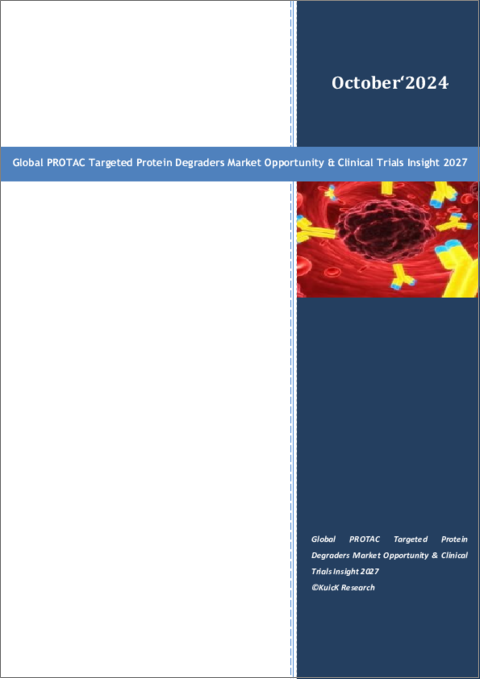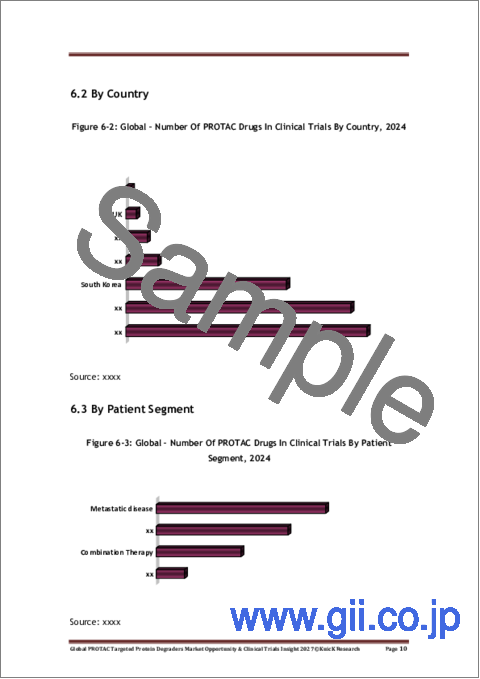|
|
市場調査レポート
商品コード
1568884
PROTAC(タンパク質分解標的キメラ)の世界市場:市場の機会と臨床試験動向(2027年)Global PROTAC Targeted Protein Degraders Market Opportunity & Clinical Trials Insight 2027 |
||||||
|
|||||||
| PROTAC(タンパク質分解標的キメラ)の世界市場:市場の機会と臨床試験動向(2027年) |
|
出版日: 2024年10月01日
発行: KuicK Research
ページ情報: 英文 180 Pages
納期: 即日から翌営業日
|
全表示
- 概要
- 図表
- 目次
| 特徴 | 詳細 |
|---|---|
| 主要セグメント | 適応症別、地域別、技術プラットフォーム別 |
| 治療領域 | がん、感染症、自己免疫・炎症性疾患、その他 |
| 対象国 | 米国、中国、韓国 |
| レポート対象範囲 | 作用機序、がんにおける可能性、包括的な臨床薬の洞察、現在の動向と将来の機会 |
| 対象企業 | Arvinas、EnhancedBio、Uppthera、TYK Medicine、Axter Therapeuticsなど |
2000年代初頭に初めて概念化されたタンパク質分解標的キメラ(PROTAC)は、標的治療における画期的なアプローチとして台頭してきています。身体の自然なユビキチン・プロテアソーム・システムを利用することで、PROTACは様々な疾患、特に歴史的に治療不可能とされてきた疾患に関与する特定のタンパク質を選択的に除去します。この革新的な治療法は、複雑な疾患を持つ患者の治療選択肢における重大なギャップを解決することに重点を置き、学術的・産業的な場面で支持を集めています。
PROTACは、ターゲティングリガンド、E3リガーゼリガンド、リンカーという3つの必須成分からなるユニークなメカニズムによって機能します。ターゲティングリガンドは、しばしば疾患病態において重要な役割を果たす関心タンパク質(POI)に特異的に結合します。これにはがんや神経変性疾患に関連するタンパク質が含まれます。E3リガーゼリガンドはPROTACをE3リガーゼ(ユビキチン分子のタンパク質への結合を促進する酵素)に結合させる。PROTACがPOIとE3リガーゼに同時に結合すると、PROTACはユビキチンの転移を触媒し、プロテアソームによる分解のために標的をマークします。このメカニズムにより、分解を促進することなくタンパク質の機能のみを阻害することが多い従来の低分子阻害剤と比べ、より効果的で正確な疾患プロセスへの介入が可能になります。
PROTACの最も顕著な応用例はがん治療です。がんには、腫瘍の成長、進行、転移、既存の治療法に対する抵抗性に寄与するタンパク質の複雑な相互作用が関与しています。PROTACは、KRAS、BRAF、サイクリン依存性キナーゼ、エストロゲン受容体やアンドロゲン受容体のようなホルモン受容体など、さまざまな主なタンパク質を標的にして分解するために開発されています。臨床試験中の候補の中では、アービナスが開発したエストロゲン受容体分解薬ベプデゲストラント(ARV-471)が際立っています。2024年10月現在、ベプデゲスラントはエストロゲン受容体陽性、ヒト上皮成長因子受容体2陰性(ER+/HER2-)乳がんの治療を適応として第3相臨床試験中です。これは、世界のパイプラインで最も進んだPROTAC候補となり、この10年末までに最初のPROTACとして上市される道を開く可能性があります。
PROTACの商業的展望は急成長しており、PROTACに基づく新しい治療法の発見と開発を加速することを目的とした戦略的共同研究によって特徴づけられます。2024年1月、GalapagosとBridGene Biosciencesは、臨床的に検証された腫瘍学的標的をターゲットとする新規精密医薬品を開発するための戦略的提携を発表しました。この提携は、両社の専門知識を活用し、PROTACの開発パイプラインを強化することを目的としています。2024年8月、両社は契約を拡大し、精密腫瘍学における選択的経口SMARCA2 PROTACの開発への取り組みも含めることとし、この新たな分野における協業精神を強調しました。
PROTAC市場は、研究の進歩と医薬品開発への投資の増加により、大きく成長すると予想されます。ユニークな作用機序と、以前は治療不可能であったタンパク質を標的にする能力により、PROTACは複雑な疾患に対する治療薬に加えられる有望な薬剤として位置づけられています。
当レポートは、世界のPROTAC(タンパク質分解標的キメラ)市場について調査し、市場の概要とともに、薬剤動向、臨床試験動向、地域別動向、および市場に参入する企業の競合情勢などを提供しています。
目次
第1章 PROTAC技術のイントロダクション
第2章 PROTAC療法のがん治療における可能性
- 標的治療としての重要性
- 従来の治療法との比較
第3章 PROTAC技術の臨床概要
- PROTAC分子の成分
- 作用機序
第4章 世界のPROTAC薬剤市場動向の洞察
- 現在の市場概要
- 将来の臨床および商業的機会
第5章 世界のPROTAC薬剤市場の動向、地域別
- 米国
- 韓国
- 中国
第6章 世界PROTAC薬剤臨床試験の概要
- 企業別
- 国別
- 患者セグメント別
- 相別
- オーファンおよびファストトラックステータス別
第7章 世界のPROTAC薬剤臨床試験の洞察:企業別、国別、適応症別、相別
- 調査
- 前臨床
- 第I相
- 第I/II相
- 第II相
- 第III相
第8章 世界のPROTAC薬剤市場の動向、適応症別
- がん
- 感染症
- 神経変性疾患
- 自己免疫疾患および炎症性疾患
- 心血管疾患
第9章 PROTAC技術プラットフォーム
第10章 世界のPROTAC薬剤市場力学と展望
第11章 競合情勢
- Arvinas
- Axter Therapeutics
- Beactica
- BioTheryX
- EnhancedBio
- Suzhou Kintor Pharmaceuticals
- Monte Rosa Therapeutics
- TYK Medicine
- Ubix Therapeutics
- Uppthera
List of Figures
- Figure 1-1: PROTACs - Evolution Across Generations
- Figure 1-2: PROTACs - Major Developmental Milestones Over The Years
- Figure 2-1: PROTACs - Advantages As Cancer Target Therapy
- Figure 3-1: PROTAC - Typical Structure
- Figure 3-2: PROTACs - Mechanism Of Action
- Figure 4-1: Global - PROTA Therapy Market Size: First 12 Month & First 5 Years Since Approval, (US$ Million)
- Figure 6-1: Global - Number of PROTAC Drugs Clinical Trials By Company, 2024
- Figure 6-2: Global - Number Of PROTAC Drugs In Clinical Trials By Country, 2024
- Figure 6-3: Global - Number Of PROTAC Drugs In Clinical Trials By Patient Segment, 2024
- Figure 6-4: Global - Number Of PROTAC Drugs In Clinical Trials By Phase, 2024
- Figure 6-5: Global - Fast Track & Orphan Designated PROTAC Drugs In Clinical Trials, 2024
- Figure 8-1: Bavdegalutamide Phase I/II (NCT03888612) Study - Initiation & Completion Year
- Figure 8-2: Bavdegalutamide Phase I (NCT05177042) Study - Initiation & Completion Year
- Figure 8-3: Vepdegestrant Phase I/II (NCT04072952) Study - Initiation & Completion Year
- Figure 8-4: VERITAC-2 Phase III (NCT05654623) Study - Initiation & Completion Year
- Figure 8-5: VERITAC-3 Phase III (NCT05909397) Study - Initiation & Completion Year
- Figure 8-6: I-SPY-2 Phase II (NCT01042379) Study - Initiation & Completion Year
- Figure 8-7: ARV-393 Phase I (NCT06393738) Study - Initiation & Completion Year
- Figure 8-8: ADVANTA Phase II (NCT06058156) Study - Initiation & Completion Year
- Figure 8-9: ZEN Phase II (NCT06028230) Study - Initiation & Completion Year
- Figure 9-1: PROTAC(R) Discovery Engine - Arvinas
- Figure 9-2: Degraducer Technology - Ubix Therapeutics
- Figure 9-3: SpeedUPP Platform - UPPTHERA
- Figure 9-4: DaTProD Platform - HealZen Therapeutics
- Figure 10-1: Global PROTAC Drugs Market - Drivers & Opportunities
- Figure 10-2: Global PROTAC Drugs Market - Challenges & Restraints
List of Tables
- Table 2-1: Comparison of PROTACs With Conventional Therapies
- Table 6-1: Cancer - Clinical Trials Assessing ARV-471
"Global PROTAC Targeted Protein Degraders Market Opportunity & Clinical Trials Insight 2027" Report Finding & Inclusions:
- First PROTAC Drug Approval Expected By 2027
- Global & Regional PROTAC Drug Market Trends Insight
- First 12 Months & First 5 Years Market Size Estimates Since Approval
- Global PROTAC Drugs Clinical Trials Insight By Company, Country, Indication & Phase: > 90 Drugs
- FDA Fast Track & Orphan Drug Status Insight By Company & Indication
- Comprehensive Insight On PROTAC Technology Platforms: 10 Platforms
- Global PROTAC Drug Market Trends By Indications
- Competitive Landscape
| Features | Details |
|---|---|
| Key Segments: | By Indication, By Region, Technology Platforms |
| Therapeutic Areas: | Cancer, Infectious Diseases, Autoimmune & Inflammatory Diseases and others |
| Countries Covered: | US, China, South Korea |
| Report Coverage | Mechanism of Action, Potential in Cancer, Comprehensive Clinical Drugs Insight, Current Trends and Future Opportunities |
| Companies Covered: | Arvinas, EnhancedBio, Uppthera, TYK Medicine, Axter Therapeutics among others |
First conceptualized in the early 2000s, proteolysis-targeting chimeras (PROTACs) are emerging as a transformative approach in targeted therapies. By harnessing the body's natural ubiquitin-proteasome system, PROTACs selectively eliminate specific proteins implicated in various diseases, particularly those that have been historically deemed undruggable. This innovative therapeutic modality is gaining traction in both academic and industrial settings, with a focus on addressing significant gaps in treatment options for patients with complex diseases.
PROTACs function through a unique mechanism that comprises three essential components: a targeting ligand, an E3 ligase ligand, and a linker. The targeting ligand binds specifically to the protein of interest (POI), which often plays a crucial role in disease pathology. This can include proteins associated with cancer or neurodegenerative disorders. The E3 ligase ligand links the PROTAC to an E3 ligase, an enzyme that facilitates the attachment of ubiquitin molecules to proteins. Once the PROTAC simultaneously binds to the POI and the E3 ligase, it catalyzes the transfer of ubiquitin, marking the target for degradation by the proteasome. This mechanism allows for a more effective and precise intervention in disease processes compared to traditional small molecule inhibitors, which often only inhibit protein function without promoting degradation.
The most prominent application of PROTACs is in cancer treatment. Cancer involves a complex interplay of proteins that contribute to tumor growth, progression, metastasis, and resistance to existing therapies. PROTACs are being developed to target and degrade a variety of key proteins, including KRAS, BRAF, cyclin-dependent kinases, and hormone receptors like estrogen and androgen receptors. Among the candidates in clinical trials, Vepdegestrant (ARV-471), an estrogen receptor degrader developed by Arvinas, stands out. As of October 2024, Vepdegestrant is undergoing phase 3 clinical trials for the treatment of estrogen receptor-positive, human epidermal growth factor receptor 2-negative (ER+/HER2-) breast cancer. This makes it the most advanced PROTAC candidate in the global pipeline, potentially paving the way to become the first PROTAC on the market by the end of this decade.
In addition to Vepdegestrant, Arvinas is also conducting a Phase 1/2 clinical trial for Bavdegalutamide (ARV-110), a PROTAC targeting the androgen receptor in patients with metastatic castration-resistant prostate cancer. This dual approach highlights the potential of PROTACs to address multiple facets of cancer biology effectively.
Beyond oncology, the application of PROTACs is expanding into the realm of autoimmune and inflammatory disorders. Researchers are exploring their potential to degrade key proteins involved in inflammatory signaling pathways. Notably, proteins from the IRAK family, especially IRAK4, and BTK kinase are being targeted for PROTAC development in these areas. While most candidates in this category are still in early phases, with few like HSK-40118 and KT-474 currently in clinical trials, ongoing research promises to uncover more viable options in the future.
The commercial landscape for PROTACs is burgeoning, characterized by strategic collaborations aimed at accelerating the discovery and development of new PROTAC-based therapies. In January 2024, Galapagos and BridGene Biosciences announced a strategic partnership to develop novel precision medicines targeting clinically validated oncology targets. This collaboration aims to leverage both companies' expertise to enhance the development pipeline of PROTACs. In August 2024, they expanded their agreement to include efforts on developing a selective oral SMARCA2 PROTAC in precision oncology, underscoring the collaborative spirit in this emerging field.
The market for PROTACs is anticipated to grow significantly, driven by advancements in research and increasing investments in drug development. The unique mechanism of action and the ability to target previously undruggable proteins position PROTACs as a promising addition to the therapeutic arsenal against complex diseases.
As the PROTAC field continues to evolve, its clinical and commercial prospects look bright. The promising early results from clinical trials and the strategic partnerships being formed indicate that PROTACs could soon revolutionize treatment paradigms for various diseases, particularly cancer and autoimmune disorders. With ongoing research and development, PROTACs are set to become a cornerstone of targeted therapy, offering new hope to patients and filling critical gaps in treatment. As we move toward the latter half of this decade, the landscape of drug development is likely to be significantly reshaped by the success of PROTAC technology.
Table of Contents
1. Introduction To PROTAC Technology
- 1.1 Overview Of PROTAC Technology
- 1.2 Development & Evolution of PROTACs
2. PROTAC Therapies Potential In Cancer Therapeutics
- 2.1 Importance As Targeted Therapy
- 2.2 Comparison With Conventional Treatment Methods
3. Clinical Overview of PROTAC Technology
- 3.1 Components Of PROTAC Molecules
- 3.2 Mechanism Of Action
4. Global PROTAC Drug Market Trends Insight
- 4.1 Current Market Overview
- 4.2 Future Clinical & Commercial Opportunities
5. Global PROTAC Drug Market Trends By Region
- 5.1 US
- 5.2 South Korea
- 5.3 China
6. Global PROTAC Drugs Clinical Trials Insight Overview
- 6.1 By Company
- 6.2 By Country
- 6.3 By Patient Segment
- 6.4 By Phase
- 6.5 By Orphan & Fast Track Status
7. Global PROTAC Drugs Clinical Trials Insight By Company, Country, Indication & Phase
- 7.1 Research
- 7.2 Preclinical
- 7.3 Phase I
- 7.4 Phase I/II
- 7.5 Phase II
- 7.6 Phase III
8. Global PROTAC Drug Market Trends By Indication
- 8.1 Cancer
- 8.2 Infectious Diseases
- 8.3 Neurodegenerative diseases
- 8.4 Autoimmune & Inflammatory Diseases
- 8.5 Cardiovascular Diseases
9. PROTAC Technology Platforms
10. Global PROTAC Drugs Market Dynamics & Outlook
- 10.1 Drivers & Opportunities
- 10.2 Challenges & Restraints
11. Competitive Landscape
- 11.1 Arvinas
- 11.2 Axter Therapeutics
- 11.3 Beactica
- 11.4 BioTheryX
- 11.5 EnhancedBio
- 11.6 Suzhou Kintor Pharmaceuticals
- 11.7 Monte Rosa Therapeutics
- 11.8 TYK Medicine
- 11.9 Ubix Therapeutics
- 11.10 Uppthera





